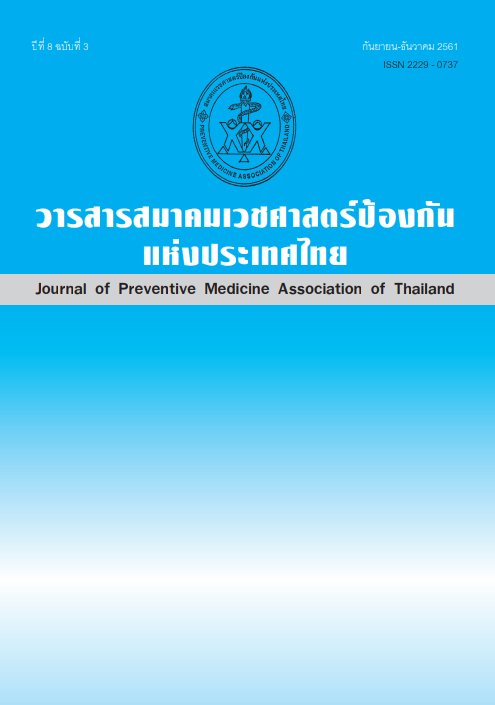The Incidence of Short Cervix in Singleton Pregnant Women between 16 and 24 Weeks of Gestation in 2017-2018
Keywords:
cervical length, preterm birth, incidenceAbstract
Preterm birth is one of the most important obstetric complications in Thailand that causes deaths and disabilities in newborns. In 2017, preterm rate was 12% in Saraburi province. Risk evaluation of preterm birth by transvaginal ultrasonography to measure cervical length in singleton pregnant women with no history of previous preterm birth is considered a good predictor to provide better assessment to their pregnancy, such as using progesterone. This survey aimed to determine the incidence of short cervix in singleton pregnant women. The retrospective study was conducted in singleton pregnant women at gestational age 16th-24th weeks with regular visits to antenatal care clinic at Saraburi hospital between 1st September 2017-28th February 2018. The results showed that the average cervical length in 275 pregnant women was 34.05 mm. Three pregnant women (1.1%) had cervical length shorter than 25 mm and 272 (98.9%) had cervical length equal or longer than 25 mm. Information of delivery can be collected in 256 pregnant women (93.1%) which 26 pregnant women (10.2%) delivered a child before GA 37th week. Of the 26 women with preterm births, one of them had short cervix while the other 25 women had normal cervical length. The one with short cervical length was significantly younger than ones with normal cervical length. In conclusion, cervical length measurement is essential in antenatal care even in those with low risk of having a preterm labor, especially teenage mother.
References
2. March of Dimes. Born Too Soon The Global Action Report on Preterm Birth. Geneva: World Health Organization; 2012.
3. Delivery Room, Saraburi Hospital. Premature labors in one year. Saraburi: ObstetricsGynecology Department, Saraburi Hospital; 2017.
4. Iams JD, Goldenberg RL, Meis PJ, Mercer BM, Moawad A, Das A, et al. The length of the cervix and the risk of spontaneous premature delivery. National Institute of Child
Health and Human Development Maternal Fetal Medicine Unit Network. N Engl J Med 1996;334(9):567-72.
5. Berghella V. Universal cervical length screening for prediction and prevention of pre-term birth. Obstet Gynecol Surv 2012;67(10):653-8.
6. Goldenberg RL, Culhane JF, Iams JD, Romero R. Epidemiology and causes of preterm birth. Lancet 2008;371(9606):75-84.
7. Mella MT, Berghella V. Prediction of preterm birth: cervical sonography. Seminar Perinatol 2009;33(5):317-24.
8. Meis PJ, Klebanoff M, Thom E, Dombrowski MP, Sibai B, Moawad AH, et al. Prevention of recurrent preterm delivery by 17 alpha-hydroxyprogesterone caproate. N Engl J
Med 2003;348(24):2379-85.
9. Sibai BM, Istwan NB, Palmer B, Stanziano GJ. Pregnancy outcomes of women receiving compounded 17 alpha-hydroxyprogesterone caproate for prophylactic prevention of preterm birth 2004 to 2011. Am J Perinatol 2012;29(8):635-42.
10. Fonseca EB, Celik E, Parra M, Singh M, Nicolaides KH. Progesterone and the risk of preterm birth among women with a short cervix. N Engl J Med 2007;357(5):462-9.
11. Hassan SS, Romero R, Vidyadhari D. Fusey S, Baxter JK, Khandelwal M, et al. Vaginal progesterone reduces the rate of preterm birth in women with a sonographic short cervix: a multicenter, randomized, double-blind, placebo-controlled trial. Ultrasound Obstet Gynecol 2011;38(1):18-31.
12. Berghella V, Odibo AO, To MS, Rust OA, Althuisius SM. Cerclage for short cervix on ultrasonography: meta-analysis of trials using individual patient-level data. Obstet
Gynecol 2005;106(1):181-9.
13. Goya M, de la Calle M, Pratcorona L, Merced C, Rodó C, Muñoz B, et al. Cervical pessary in pregnant women with a short cervix (PECEP): an open-label randomised controlled trial. Lancet 2012;379(9828):1800-6.
14. Ibrahim MI, Harb HM, Ellaithy MI, Awad EM. Diagnostic validity of cervicovaginal human chorionic gonadotrophin at 26-36 weeks of gestation as a biochemical predictor of preterm birth. J Obstet Gynaecol 2013;39(6):1121-8.
15. Saade GR, Boggess KA, Sullivan SA, Markenson GR, Iams JD, Coonrod DV, et al. Development and validation of a spontaneous preterm delivery predictor in asymptomatic women. Am J Obstet Gynecol 2016;214(5):633-56.
16. Myers KM, Feltovich H, Mazza E, Vink J, Bajka M, Wapner RJ, et al. The mechanical role of the cervix in pregnancy. J Biomech 2015;48(9):1511-23.
17. Practice bulletin no. 171: Management of preterm labor. Obstet Gynecol 2016;e155-64.
18. Preterm labor. In: Cunningham FG, Leveno KJ, Bloom SL, Dashe JS, Hoffman BL, Casey BM, Spong CY, editors. Williams Obstetrics. 25th ed. New York: McGraw-Hill Education; 2018. p.1780-850.
19. Maerdan M, Shi C, Zhang X, Fan L. The prevalence of short cervix between 20 and 24 weeks of gestation and vaginal progesterone for prolonging of gestation. J Matern
Fetal Neonatal Med 2017;30(14):1646-9.
20. Pattanapanyasat N, Luengratsameerung S, Charoenchainont P. Comparison of the cervical length during second trimester of pregnancy between teenage and adult primigravidae. Thai J Obstet Gynaecol 2016;24(1):14-9.
21. Conde-Agudelo A, Romero R, Da Fonseca E, O’Brien JM, Cetingoz E, Creasy GW, et al. Vaginal progesterone is as effective as cervical cerclage to prevent preterm birth in women with a singleton gestation, previous spontaneous preterm birth, and a short cervix: updated indirect comparison meta-analysis. Am J Obstet Gynecol. 2018;219(1):10-25.
22. Tongsong T, Kamprapanth P, Pitaksakorn J. Cervical length in normal pregnancy as measured by transvaginal sonography. Int J Gynaecol Obstet 1997;58(3):313-5.
23. Stevens-Simon C, Barret J, McGregor JA, French J, Persutte W. Short cervix: a cause of preterm delivery in young adolescents?. J Matern Fetal Med 2000;9(6):342-7.
24. D’Agostini C, de Oliveira M, D’Souza-Li L. Comparison of cervical length in adult and adolescent nulliparae at mid-gestation. J Pediatr Adolesc Gynecol 2013;26(4):209-11.
25. Romero R, Conde-Agudelo A, Da Fonseca E, O’Brien JM, Cetingoz E, Creasy GW, et al. Vaginal progesterone for preventing preterm birth and adverse perinatal outcomes in singleton gestations with a short cervix: a meta-analysis of individual patient data. Am J Obstet Gynecol 2018;218(2):161-80.
26. Sirichotiyakul S. Intrapartum and premature rupture of membranes care. In: The Royal Thai College of Obstetricians and Gynaecologists. OBGYN Clinical Practice Guidelines. 2nd ed. Bangkok: The Royal Thai College of Obstetricians and Gynaecologists; 2015. p.15-41.
Downloads
Published
How to Cite
Issue
Section
License
บทความที่ลงพิมพ์ในวารสารเวชศาสตร์ป้องกันแห่งประเทศไทย ถือเป็นผลงานวิชาการ งานวิจัย วิเคราะห์ วิจารณ์ เป็นความเห็นส่วนตัวของผู้นิพนธ์ กองบรรณาธิการไม่จำเป็นต้องเห็นด้วยเสมอไปและผู้นิพนธ์จะต้องรับผิดชอบต่อบทความของตนเอง






